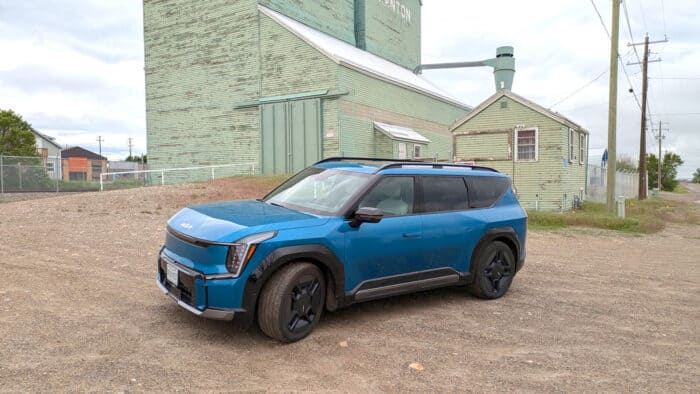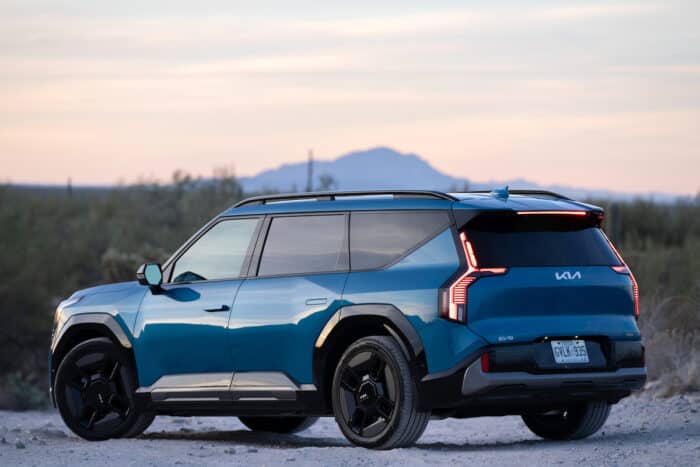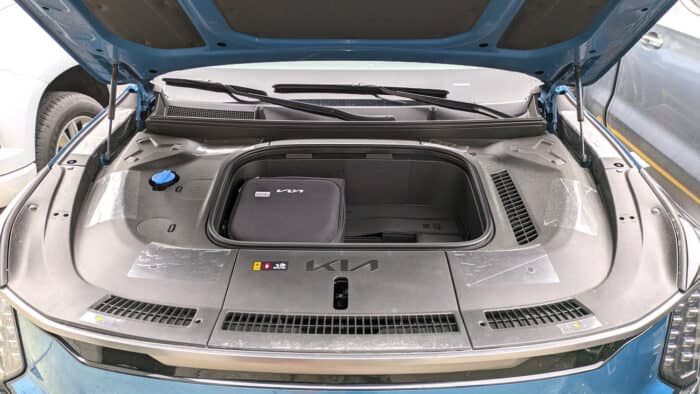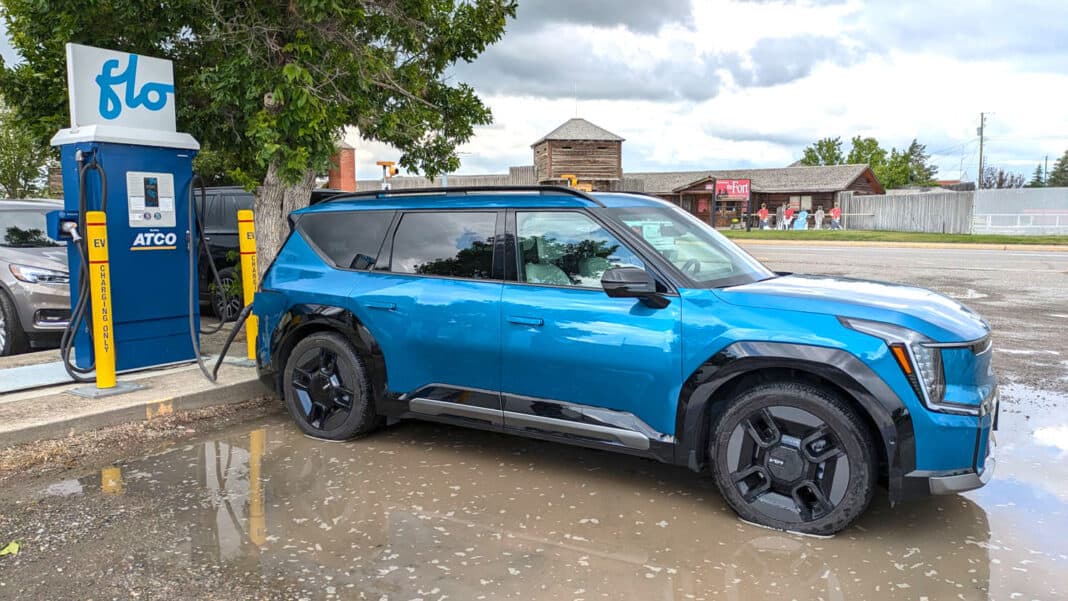Three-row family transport has been noticeably lacking among the EVs that have appeared in North America so far. Kia is the first mainstream brand to bring one to market – packaged as an SUV rather than an unfashionable minivan, as you’d expect, expanding Kia’s lineup of SUVs and crossovers.
Performance and Driving Impressions

We spent a week with the AWD EV Land with the optional GT-Line package. That adds C$14,000 (US$10,000) to the C$64,995 (US$47,500) base price; on the road the total is C$81,495 (US$59,500).
Alongside some town driving, we took the EV9 on a road trip from Calgary down to beautiful Waterton Lakes National Park on the border with Montana, a distance of 280km each way. With a quoted maximum range of 435km, this provided a good test in a province where the fast recharging infrastructure is not as well developed as in jurisdictions where EV sales (and purchase incentives) are higher.
For now, the VinFast VF9, Rivian R1S, and Volvo EX90 are the only three-row EV alternatives.
For us, the EV9 was no more than satisfactory on the highway. Power and torque are rarely the issue with modern EVs: comfort and refinement are the points of differentiation. The car didn’t track as truly as you’d want, forcing unexpected corrections when it drifted out of lane. We also found that it struggled to stay straight over bigger bumps and potholes, with a pronounced bump-steer that is rare in modern vehicles.

We’re not sure whether these problems were specific to this particular EV9 or a wider issue, but we’re sure that the GT-Line Package’s 21-inch rims – the largest available – do the rolling refinement no favours, either around town or at speed.
The test car had the latest and greatest driver-assistance systems, which mostly worked well. However, we needed to leave huge gaps when overtaking to avoid triggering the oversensitive Blind-Spot Collision Warning (BCW) system, so we switched it off – which thoroughly negates the point of having it.
Here’s our 2024 Kia EV9 GT-Line first drive review with more impressions.
Interior with the GT-Line Package

A 5m vehicle that enjoys all the packaging advantages that EVs bring should have no shortage of space inside. The EV9 is big, but no TARDIS. The GT-Line Package reduces legroom for third-row occupants, which at 760mm is 40mm less than a Telluride (the Premium Package offers the most space). I wouldn’t have wanted to ride to Waterton in the very back, but the space is fine for occasional use.
| Dimension | Kia EV9 | Kia Telluride |
|---|---|---|
| Length | 197.4 inches (approx.) | 196.9 inches |
| Width | 78.0 inches (approx.) | 78.3 inches |
| Height | 69.0 inches (approx.) | 68.9 inches |
| Ground Clearance | 7.8 inches | 8.0 inches |
| Towing Capacity | Up to 5,000 lbs | Up to 5,000 lbs |
There’s not as much cargo space as you’d expect, either. It’s the classic SUV problem of a high sill for loading, with the drivetrain consuming potential low-down storage space. Nor does the frunk ride to your rescue – it’s barely large enough to store the coiled-up home charging cable.

The overall interior feel is premium, though. The seats are especially comfortable and there’s even a massage function that automatically kicked in when I’d be driving for an hour. Less premium was the sometimes-fuzzy FM radio reception – even right in the city – while for this reviewer, haptic buttons – featured here on the sleek dash – remain a triumph of form over function.
Efficiency & charging

We recorded average energy consumption of 5.0km/kWh over the 753km, week-long test, which happily translates to better efficiency than the official figure of 4.5km/kWh (based on usable energy of around 96kWh – pack total is a 99.8kWh – and an official range of 435km).
With a pack this size, you need DC fast charging to make longer journeys feasible. We tried a couple of 50kW chargers on the Flo/ATCO network and got charge rates of 49kW from each (36.6kWh delivered in 45 minutes, battery charge up from 49% to 81%, translating to about 150km of range added). Integration through the Chargepoint app worked fine.
There were no problems either when visiting an Electrify Canada station that promised 150kW charging but peaked at 73kW (49.8kWh delivered in 43 minutes, 12% to 60% charge, about 228km of range added).
Takeaway
Pros:
- Spacious interior with comfortable seating
- Impressive energy efficiency exceeding official estimates
- Premium features like massage seats and advanced driver assistance
Cons:
- Disappointing ride and handling
- Limited third-row legroom and cargo space
- Oversensitive blind-spot warning system
The EV9 fills a gap in the market. For now, the VinFast VF9, Rivian R1S, and Volvo EX90 are the only three-row EV alternatives. The Kia is the lowest-priced and most mainstream of the foursome, and many will be drawn to its distinctive, chunky styling.
But this is still an SUV, with the associated compromise in outright space, not to mention excessive weight. We won’t save the planet in cars that weigh 2,666kg (5,878 lb). The EV3, on the other hand, expected to launch as a 2026 model, is arguably the affordable family EV that the market needs right now.



